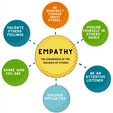Adding empathy to your enrollment marketing communications
9/13/2023
We’re living in a time characterized by exciting technology and fast progress. As marketers, we gain more tools, more time, and more possibilities with each new development.
That’s why it’s so important, as we think about enrollment communications, to take a minute and remember what it means to be human, and to consider how, as humans, we relate to other humans.
Think about a traditional college student. They’re going through a major life transition. They’re making decisions about who they are today and who they want to be tomorrow. For some, it may be the first time they’re on their own. And in today’s societal climate, the stress of this transition is exacerbated by uncertainty, fear, cost, and more.
When we’re designing communications to attract them to our schools, how often do we think about this and put ourselves in their shoes? Not enough.
We can build more genuine connections with our future students by adding empathy to the ways we communicate with them.
Communicating throughout the college-search journey
To generate interest for our college or university, we build a series of communications based on what’s widely known as the enrollment funnel. Through this flow of communications, we hope to compel prospective students to apply and commit to our institutions.
The typical funnel for a traditional college-bound student is broken up into five stages.
- Awareness: Students are seeking quick answers to their top questions: reputation, programs, location, belonging, and cost.
- Consideration: Students are digging deeper, trying to reduce their options to a short list of schools they’re actually going to apply to.
- Application: They have either started or completed an application, and the information they need turns transactional.
- Evaluation: If they’re accepted, here they’re looking for the most detailed information possible, so they can choose just one school to commit to. This is like a test-drive.
- Commitment: After they commit, they still need to take quite a few steps, so the info they want here is an orderly and easy-to-understand sequence of steps.
When we think of the funnel this way, we focus solely on information, and we miss an opportunity to connect with students as human beings.
This is where empathy comes in.
Source: Georgian College (2022)
Empathy creates connection
Empathy is the awareness of the feelings of others, and also the capacity to feel them yourself. We do this by imagining ourselves in our prospects’ shoes — by listening, being curious, finding commonalities, validating their feelings, and sharing what we feel, too.
How can we develop empathy for our audiences? Well, we have to take a step back from the information we need to send and uncover what our audience might be feeling. Empathy maps help us do just that.
An empathy map has four quadrants: thinking, feeling, seeing, and doing.
- Thinking: What are the rational thoughts in their head? What tasks and process questions do they have? What facts are they seeking?
- Seeing: What channels are they using? Where are they seeing information related to us, but also related to their own hobbies and interests?
- Doing: What are they doing? What are their responsibilities, their daily activities, and the other things that occupy their time?
- Feeling: How are they feeling about going to college? How are they feeling about their activities, relationships, responsibilities?
It’s important that, when you complete this exercise for your audiences, you actually do it with them. You can host focus groups, conduct one-on-one interviews, or field a simple survey. And it’s a good idea to create maps for each of your priority segments, and not just one map for your entire audience, since different students will experience your process in different ways.
Empathy map × enrollment funnel
Here’s where things get fun. Let’s connect this back to the enrollment funnel.
Students are feeling so much through this process, and it isn’t all rosy. At first, they’re dreaming, maybe optimistic, but also hesitant. They get progressively more confused, anxious, and overwhelmed, with a few moments of elation in between. Then they oscillate from excited to terrified, happy to sad.
Here’s what this roller coaster of emotions might look like for them.
And yet, here’s how we communicate.
Imagine how jarring this is! You’re deep in the throes of anxiety, and you get an enthusiastic email about how your room has air conditioning. Or you’re so sad to leave your friends and family, only to get a presumptuous email that says the rest of your life starts now! Or you’re scared you won’t be able to afford your education, then you get an email talking about millions of dollars in scholarships, but you have no idea how much of that you could get. It’s alienating.
How do we add empathy?
It’s really simple, actually. We just have to feel with them. When they’re on this roller coaster of emotions, hop on. We’re excited. We acknowledge that it’s a lot. We’re hopeful with them. We’re sorry with them. We’re ecstatic with them. And honestly, that’s super easy to do.
The bottom line
When we focus only on information, we miss opportunities to create connections. We might even push students away. We can add empathy to our communications by mapping out what students are thinking, feeling, seeing, and doing. All we have to do is feel with them. Not just so they choose us, but because it’s the human thing to do.
—
Day delivered a talk based on this content at the 2023 Engage Summit. Watch the presentation to get more details and examples.










